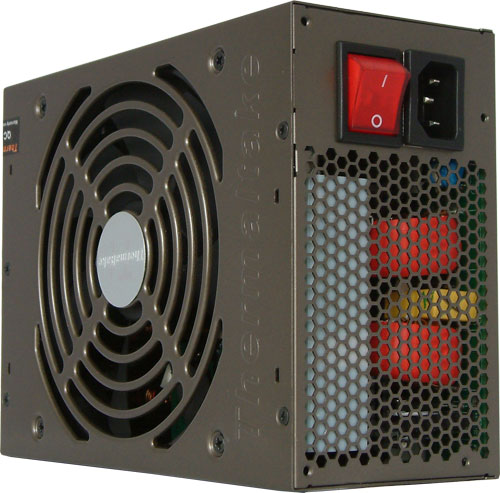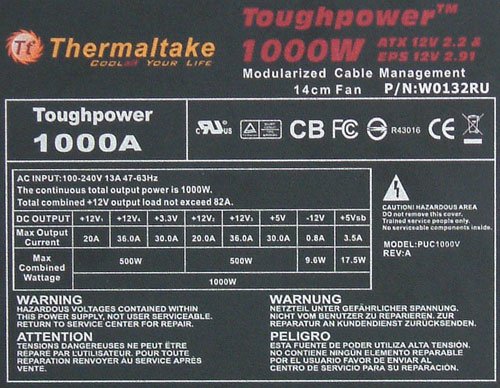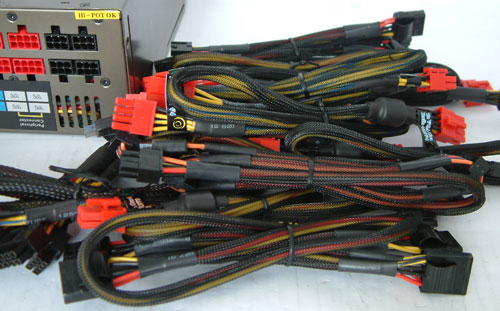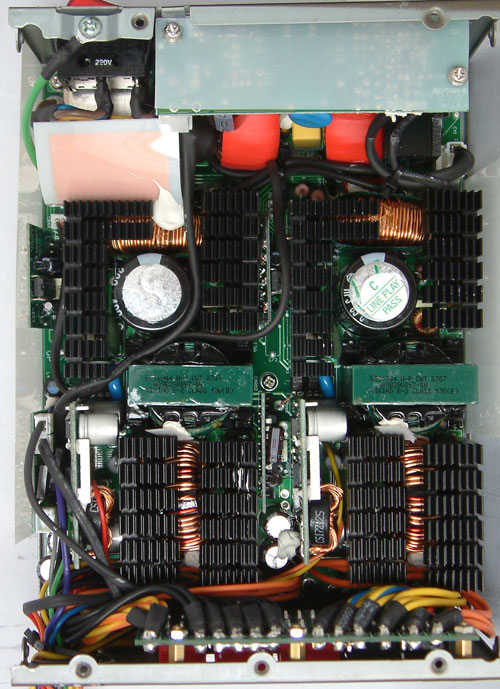Power Supply Roundup: Eight 1000W for the Extreme Users
by Christoph Katzer on December 11, 2007 9:30 PM EST- Posted in
- Cases/Cooling/PSUs
Thermaltake Toughpower 1000W (W0132RU)

Thermaltake power supplies are often quite nice to look at, and the bronze palette fits nicely with the red of the button and the cover for the coils. The power supply is quite long - we'll find out why in a moment. One thing that perplexes us is the fan-grill for the large fan on the bottom. Thermaltake punches holes in the casing, making the use of a separate grille unnecessary. The problem with this method is the decreased amount of air that can pass through the holes. If you compare a normal fan-grille to this one, it is obvious the standard fan-grille will allow for better airflow. To compensate, it may be necessary to run the fan at higher RPMs, which is not something most people desire.

The label is quite different from what we are used to with other power supplies. This has something to do with the fact that there are in fact two power supplies inside the chassis. We will see this when we open up the unit. The left side shows two 12V rails with the 3.3V rail together and a maximum combined power of 500W. The right side shows two 12V rails and the 5V rail together with a maximum of 500W as well. Together that is 1000W. Each of the 12V rails is equipped with either 20A or 36A. The 36A on each side will be useful for the highest-end graphics cards.

Thermaltake includes a vast amount of cable harnesses as can be seen in the shot above. There are six PCI-E connectors - three 6-pin and three 6/8-pin. The length varies from 45 to 60cm. There are four additional peripheral harnesses, providing six Molex and six SATA connectors in total.

Now comes the interesting part. As we can clearly see, there are two separate power supplies inside the housing. Each one has its own PFC stage, transformer, and secondary stage with all solid capacitors. This means each part shares only the input filtering stage. We saw this topology with the PC Power & Cooling Turbo Cool 1200W and the performance was very good. The only problem was the lack of airflow through the power supply, and we will see if Thermaltake fares better in this regard. PC Power & Cooling used two separate PCBs, vertically mounted on the main PCB. Thermaltake took a different approach and installed two circuits on one PCB. The advantage of the Thermaltake design is better cooling for the components. The fan blows directly at the components and heatsinks.










29 Comments
View All Comments
jonnyGURU - Wednesday, December 12, 2007 - link
The X3 is not the "oldest" of the units tested. The X3 has only been out since the beginning of this year. The Galaxy, ProXstream and Strider have all been on the market longer.Also, to determine voltage regulation you're supposed to compare a voltage from zero to full load. Not gauge how close to a mean value the voltage at three different loads.
For example: According to your tests, a PSU that went from 3.5V to 3.4V going from no to full load isn't as good as one that goes from 3.4V to 3.2V. 3.2V and 3.4V are both only one volt from 3.3V, but there's a 0.2V fluctuation in voltage going from zero to full load. The unit that wouldn't be considered as good actually only has a 0.1V fluctuation.
jonnyGURU - Wednesday, December 12, 2007 - link
To elaborate using your own numbers....Look at the +5V. The Quattro is "top" during all three load test results with 5.12V, 5.01V and 4.91V because it was "closer to +5V."
Now look at the Ultra X3. It scored second lowest in two tests and lowest in another with 4.96V, 4.83V and 4.78V because they weren't "as close."
But do the math...
Antec: 5.12V - 4.91V = 0.21V
Ultra: 4.96V - 4.78V = 0.18V
It's a close race, but the Ultra actually exhibits BETTER regulation that the Antec.
We can do the same with the +12V results.
The Strider scored #1 twice and then #2. The Antec scored second from last twice and then third from last. But now do the math.
Strider: 12.27V - 11.84V = 0.43V
Antec: 12.08V - 11.78V = 0.30V
Again, your analysis fails to agree with reality.
jonnyGURU - Wednesday, December 12, 2007 - link
Next time I'll try to get all my thoughts together in one post. ;)Where did you get your pricing from?
Specifically, the US pricing?
Some companies provide an MSRP, while others do not. MSRP is typically "worst case scenario" so a retailer isn't embarassed by having an unusually high price. So did you use some MSRP numbers and some numbers based on what you could Google the product for?
For example: $280 for the X3? I'm seeing it for a price TYPICALLY below $250. $250 for the Antec? Let's do an apples to apples price comparison. At Provantage an X3 is $239. An Antec is only $197! And the OCZ that you price at $250? It's actually a little more at Provantage at $254.
What are you doing man????
Christoph Katzer - Wednesday, December 12, 2007 - link
...and I thought you just like to see your own writing. The biggest problem is that all articles need to be interesting for enthusiasts and of course still be accessible for everybody else as well. I tried many ways until now and I am now at a point where the information in the article seems to be easiest to understand.Voltage Regulation: I disagree here. If a PSU starts with 11.70 and goes down to 11.50V is has only 0.20 fluctuation, nice. Would you say it's a good PSU? I dont think so. 99.9% of the users don't really care about fluctuation and just want to know which one is closest to the ideal. This little over-voltage isn't as bad as much under-voltage. And here again, we need to keep the info accessible. Otherwise I couldn't write roundups anymore since I would need 10 pages per PSU.
US-pricing is difficult, I agree. Not as transparent as I know from Europe.
jonnyGURU - Wednesday, December 12, 2007 - link
Well Chris... that's where a little jounalism has to come into play. If a PSU has tight regulation, but still falls within spec, then OF COURSE it's not acceptable, but if it's only 1 or 2% off where the ATX12V allows for as much as 5%, then you can't shank a PSU for having good regulation.Pretty much all of the units stayed within spec on all rails. And I'm sure we can contribute most of the drop in voltage to resistance, yet units with better regulation are getting put towards the bottom of the list simply because they're not "closest" to the mean voltage. It just doesn't make sense.
As for pricing, the best thing I can suggest is Froogle (aka Google Products.) Sort by relevance and find the average price or sort low to high and see what price has the most instances.
beoba - Tuesday, December 11, 2007 - link
It'd be useful if you demonstrated a system which was actually capable of using that capacity, even moreso if you showed what a mainstream user would need for a modern system. Just throw together some example configurations and show what wattage they actually use.strikeback03 - Wednesday, December 12, 2007 - link
Check the test for the HP Blackbird (http://www.anandtech.com/systems/showdoc.aspx?i=30...">http://www.anandtech.com/systems/showdoc.aspx?i=30... - OCed quad-core, Crossfire HD X2900 XT cards, 2 hard drives, water cooling, etc. Drew 370W at idle and 740 at load.JarredWalton - Wednesday, December 12, 2007 - link
Of course, technically that's at the outlet, so the PSU is only putting out (assuming 80% efficiency, which is probably close) 300-600W. The thing is, I don't believe you *want* to run your PSU at anything near capacity; 60-80% at full load from a system seems "safe" to me, so if that's what you're looking at then 1000W PSUs are a good idea.We also have triple GPU (probably quad as well) setups coming from AMD and NVIDIA. That's another ~100-200W or so. For people that go into killer overclocking (i.e. LN2 or phase), you really need a massive PSU. That's not a huge market, though.
Carnildo - Wednesday, December 12, 2007 - link
I've been looking into building a new system, and I've been amazed at the PSU wattage I'd need:
* Single quad-core CPU, 4GB RAM, Intel graphics: 300W.
* Single quad-core CPU, 8GB RAM, single high-end graphics card: 400W.
* Dual quad-core CPU, 8GB RAM, single high-end graphics card: 550W.
Just at a guess, there are three classes of system that need a 1000W+ power supply:
* Top-end workstations: 16 CPU cores, 4-way SLI, and 16-32 GB of RAM.
* Systems with a lot of hard drives. 20 hard disks starting up could easily draw that much power for a second or two.
* Systems with Peltier-effect cooling.
Christoph Katzer - Wednesday, December 12, 2007 - link
Exactly. There aren't actually many systems with the need for such a power but still every second user thinks he would need one. But no worries... be have articles to clear things up.